New British Arctic Strategy: Deploying Submarine-Hunting Aircrafts to the Arctic

British Defense Minister Ben Wallace and Norwegian Defense Minister Odd Roger Enoksen (Center party) visiting the NATO exercise Cold Respones 2022 in Bardufoss, Norway. (Photo: Norwegian Armed Force)
Great Britain sends jets with specialized surveillance technology to the Arctic as part of Britain’s new Arctic strategy. The Norwegian Defense Minister welcomes increased British presence.
On Tuesday, Great Britain’s Defense Minister Ben Wallace presented the country’s new Arctic strategy.
It says the High North and maintaining the defense of the North Atlantic still will be of major importance to Britain and that the British navy will be permanently active in the Nordics in the coming time.
The British Ministry of Defense wants to secure that it remains capable of protecting Great Britain’s interests when the region opens up in the coming years due to melting sea ice.
Wallace is currently in Norway visiting the NATO exercise Cold Respones in Bardufoss on Tuesday and the Russian border in Sør-Varanger on Wednesday. At a press conference during the visit, Wallace said that Great Britain will commit militarily to the Nordics in order to protect the North Atlantic.
The forces are likely to rotate between Norway, Sweden, Finland and other places in the region.
Anti-submarine fighter planes
During the strategy launch, he also said that Great Britain will deploy anti-submarine fighter planes to the Arctic as increased access means increased threat from Russia. the planes belong to the Royal Air Force and are a part of nine P-8 Poseidon maritime surveillance planes from Lossiemouth military airport in Moray specially designed for monitoring Russian submarine activity.
The document says Moscow has invested in military infrastructure and equipment for sea ice, established a new Arctic joint strategic command and reopened bases from the Cold War north of the Arctic Circle, including on Franz Joseph’s Land, which came operative in 2018, and the Kotelny Island base opening in December 2016.
“The High North means a lot to Great Britain and the British defense. The development in the Arctic has an impact on our environment, our wealth, our energy supply and our security”, Wallace says.
Like during the Cold War
He points out that as the region’s nearest non-Arctic neighbor, Great Britain will continue working with its allied and partners to secure increased access to the region and that the resources there can be managed in a safe, sustainable, and responsible way.
The MoD writes in its 16-page document that Russian submarine activity in the North Atlantic now has reached Cold War levels.
“The Arctic has historically been a low-tension area and we want it to remain that way”, Ben Wallace says.
Threats and opportunities
In order to secure the Arctic against increased tension, the British MoD has decided that a marine company, two amphibious warships and helicopters, which constitute Britain’s coast-near response group, will be periodically deployed to the Arctic.
Defense Minister Ben Wallace says that less sea ice brings threats as well as opportunities; Russia’s increasingly militarized approach to the region as well as China’s support around the Polar Silk Road opens up for a series of challenges related to infrastructure as well as new opportunities.
As the region is growing increasingly accessible, threats from other places around the world may spill over into the Arctic
That is why cold weather training will be extended from Norway to Canada, Finland and the USA on a regular basis, so that an increasing number of soldiers are prepared to operate in sub-zero degrees.
“As the region is becoming increasingly accessible, threats from other places around the world may spill over into the Arctic, Wallace says.
An end to isolation
The strategy, which is a ten-year plan, was first announced in 2018, though it was delayed. In it, one can read that “The era of Arctic isolation is over.”
“We have to be able to be present during the changing regional dynamics coming as a consequence of decreasing sea ice”, Wallace stated.
The strategy says that while there is a series of potential threats in the Arctic, “a worsened global security environment constitutes the largest threat against security in the region.”
“Being a leading European state and NATO ally, Great Britain will defend our allies if the need were to arise”, the defense minister says.
“That is why the British armed forces will practice more with our close Arctic allies and partners, as part of NATO, both bilaterally as well as through other multilateral groups”, Wallace said.
He adds that the British air force will continue participating in Icelandic defense missions in which British war planes patrol the island.
New opportunities
“The unique environment in the Arctic will continue offering operational challenges and demanding new approaches and solutions”, Wallace says.
That is why the British defense will make new investments and conduct research on new opportunities in space technology.
"This strategy describes the Defense’s approach to the region with a broader interstate Arctic policy and demonstrates the region’s significance in the coming years”, Wallace says in closing.
Norwegian Defense Minister Odd Roger Enoksen (Center party) welcomes the British initiative.
“We welcome more allied activity in the North”, Enoksen says.
Also read
This article was originally published in Norwegian and has been translated by HNN's Elisabeth Bergquist.



